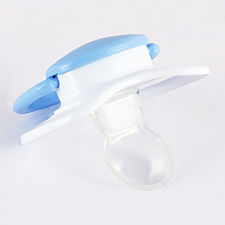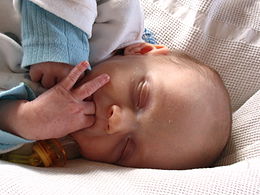
Sudden infant death syndrome (SIDS), sometimes known as cot death, is the sudden unexplained death of a child of less than one year of age. Diagnosis requires that the death remain unexplained even after a thorough autopsy and detailed death scene investigation. SIDS usually occurs during sleep. Typically death occurs between the hours of midnight and 9:00 a.m. There is usually no noise or evidence of struggle. SIDS remains the leading cause of infant mortality in Western countries, constituting half of all post-neonatal deaths.
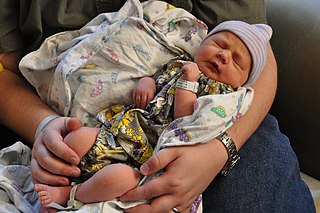
An infant or baby is the very young offspring of human beings. Infant is a formal or specialised synonym for the common term baby. The terms may also be used to refer to juveniles of other organisms. A newborn is, in colloquial use, an infant who is only hours, days, or up to one month old. In medical contexts, a newborn or neonate is an infant in the first 28 days after birth; the term applies to premature, full term, and postmature infants.

The nipple is a raised region of tissue on the surface of the breast from which, in females, milk leaves the breast through the lactiferous ducts to breastfeed an infant. The milk can flow through the nipple passively or it can be ejected by smooth muscle contractions that occur along with the ductal system. Male mammals also have nipples but without the same level of function, and often surrounded by body hair.
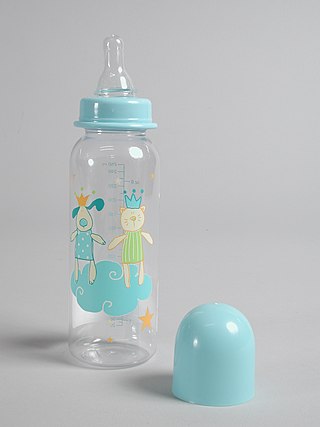
A baby bottle, nursing bottle, or feeding bottle is a bottle with a teat attached to it, which creates the ability to drink via suckling. It is typically used by infants and young children, or if someone cannot drink from a cup, for feeding oneself or being fed. It can also be used to feed non-human mammals.
Co-sleeping or bed sharing is a practice in which babies and young children sleep close to one or both parents, as opposed to in a separate room. Co-sleeping individuals sleep in sensory proximity to one another, where the individual senses the presence of others. This sensory proximity can either be triggered by touch, smell, taste, or noise. Therefore, the individuals can be a few centimeters away or on the other side of the room and still have an effect on the other. It is standard practice in many parts of the world, and is practiced by a significant minority in countries where cribs are also used.

Teething is the process by which an infant's first teeth appear by emerging through the gums, typically arriving in pairs. The mandibular central incisors are the first primary teeth to erupt, usually between 6 and 10 months of age and usually causes discomfort and pain to the infant. It can take several years for all 20 teeth to complete the tooth eruption. Though the process of teething is sometimes referred to as "cutting teeth", when teeth emerge through the gums they do not cut through the flesh. Instead, hormones are released within the body that cause some cells in the gums to die and separate, allowing the teeth to come through.
A comfort object, more formally a transitional object or attachment object, is an item used to provide psychological comfort, especially in unusual or unique situations, or at bedtime for children. Among toddlers, a comfort object often takes the form of a blanket or a stuffed animal, doll or other toy, and may be referred to by a nickname such as blankie.

In orthodontics, a malocclusion is a misalignment or incorrect relation between the teeth of the upper and lower dental arches when they approach each other as the jaws close. The English-language term dates from 1864; Edward Angle (1855–1930), the "father of modern orthodontics", popularised it. The word "malocclusion" derives from occlusion, and refers to the manner in which opposing teeth meet.

The Haberman Feeder is a speciality bottle named after its inventor Mandy Haberman for babies with impaired sucking ability. The design of the feeder is to simulate breastfeeding.
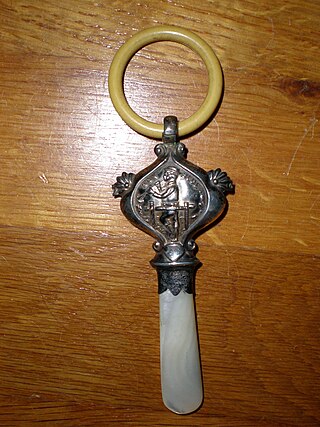
A teether, teething toy, or chew toy is a device given to teething infants. Teether is evolving not only for a baby but also for adults. It has the effect of reducing the pain of irritable wisdom teeth. Most modern teethers are silicone, but can also be made of wood or rubber. Some teethers are filled with a fluid or gel that can be frozen or refrigerated. They differ from pacifiers in that they are intended to be chewed, rather than sucked on. They come in a variety of different shapes. Teethers may help relieve teething pain and help new teeth penetrate the gum, as well as provide a form of entertainment. Studies found that chewing a teether may make teething children calmer and happier, less stressed, and less cranky. Teething necklaces and teething bracelets may pose a choking hazard to infants and toddlers depending on the teething parts, and have prompted recalls. Teethers filled with liquid have also been recalled because of bacterial contamination. Early teethers were often teething rings.
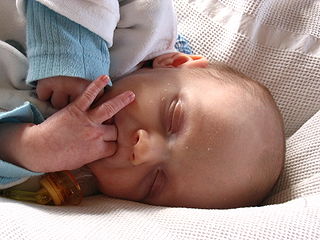
Thumb sucking is a behavior found in humans, chimpanzees, captive ring-tailed lemurs, and other primates. It usually involves placing the thumb into the mouth and rhythmically repeating sucking contact for a prolonged duration. It can also be accomplished with any organ within reach and is considered to be soothing and therapeutic for the person. As a child develops the habit, it will usually develop a "favourite" finger to suck on.

Breastfeeding difficulties refers to problems that arise from breastfeeding, the feeding of an infant or young child with milk from a woman's breasts. Although babies have a sucking reflex that enables them to suck and swallow milk, and human breast milk is usually the best source of nourishment for human infants, there are circumstances under which breastfeeding can be problematic, or even in rare instances, contraindicated.

Breastfeeding, or nursing, is the process by which human breast milk is fed to a child. Breast milk may be from the breast, or may be pumped and fed to the infant. The World Health Organization (WHO) recommends that breastfeeding begin within the first hour of a baby's life and continue as often and as much as the baby wants. Health organizations, including the WHO, recommend breastfeeding exclusively for six months. This means that no other foods or drinks, other than vitamin D, are typically given. The WHO recommends exclusive breastfeeding for the first 6 months of life, followed by continued breastfeeding with appropriate complementary foods for up to 2 years and beyond. Of the 135 million babies born every year, only 42% are breastfed within the first hour of life, only 38% of mothers practice exclusive breastfeeding during the first six months, and 58% of mothers continue breastfeeding up to the age of two years and beyond.
PAL: Pacifier Activated Lullaby is a pacifier fitted with an adapter, which houses a computer chip that activates a CD player outside the incubator. Developed in 2000 by Dr. Jayne M. Standley along with the Center for Music Research at Florida State University, the PAL is used during music therapy interventions in the neonatal intensive-care unit to promote and reinforce non-nutritive sucking (NNS) opportunities on premature infants. Dr. Standley found that infants could differentiate between silence and musical stimuli, which meant infants could be positively reinforced with music when they sucked with enough endurance and strength.
Infant feeding is the practice of feeding infants. Breast milk provides the best nutrition when compared to infant formula. Infants are usually introduced to solid foods at around four to six months of age.
Open bite is a type of orthodontic malocclusion which has been estimated to occur in 0.6% of the people in the United States. This type of malocclusion has no vertical overlap or contact between the anterior incisors. The term "open bite" was coined by Carevelli in 1842 as a distinct classification of malocclusion. Different authors have described the open bite in a variety of ways. Some authors have suggested that open bite often arises when overbite is less than the usual amount. Additionally, others have contended that open bite is identified by end-on incisal relationships. Lastly, some researchers have stated that a lack of incisal contact must be present to diagnose an open bite.
Infant and toddler safety are those actions and modifications put into place to keep babies and toddlers safe from accidental injury and death. Many accidents, injuries and deaths are preventable.
Nipple confusion is the tendency of an infant to unsuccessfully adapt between breast-feeding and bottle-feeding. It can happen when the infant is put back onto breast-feeding. Nipple confusion can turn into nipple refusal in which the infant refuses both the bottle and breastfeeding.
In breastfeeding women, low milk supply, also known as lactation insufficiency, insufficient milk syndrome, agalactia, agalactorrhea, hypogalactia or hypogalactorrhea, is the production of breast milk in daily volumes that do not fully meet the nutritional needs of her infant.
Nipple pain is a common symptom of pain at the nipple that occurs in women during breastfeeding after childbirth. The pain shows the highest intensity during the third to the seventh day postpartum and becomes most severe on the third day postpartum.
